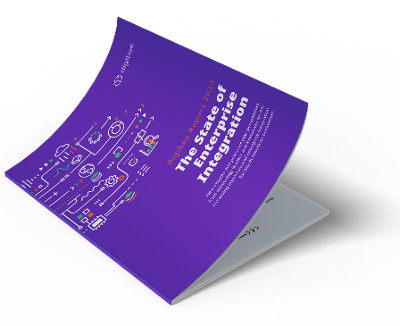outubro 3, 2022
Os profissionais de desenvolvimento empresarial de hoje enfrentam desafios novos e maiores do que seus predecessores. A demanda por projetos de transformação digital está disparando à medida que as organizações buscam manter uma vantagem competitiva em um mercado global e digital-first. Ao mesmo tempo, os orçamentos estão mais restritos e a oferta de desenvolvedores qualificados e arquitetos de sistemas é limitada.
A arquitetura de integração empresarial está sendo empurrada para o final da crescente lista de projetos tecnológicos que as equipes de TI enfrentam. As equipes de desenvolvimento estão sentindo a pressão ao equilibrar a manutenção regular dos sistemas com novas tarefas e inovações, muitas vezes com apenas uma equipe reduzida. E, por mais que se esforcem, muitas vezes são vistas por outros departamentos como um obstáculo ao progresso, e não como facilitadores dos negócios.
Mas é por isso que a integração é importante. Estratégias e soluções legadas simplesmente não conseguem resolver os problemas empresariais de hoje. Então, como os desenvolvedores e arquitetos de sistemas estão lidando com esses desafios? Qual o papel deles na estratégia de integração empresarial e o que isso significará para seus departamentos?
>> Agende uma demonstração personalizada com nossa equipe de especialistas e veja como o iPaaS da Digibee trará eficiência ao seu negócio.
A TI é responsável pela integração?
A integração empresarial pode ser um divisor de águas para as empresas – mas não é uma tarefa simples. Onde a responsabilidade de lidar com os desafios da integração deve recair?
Curiosamente, 50% das empresas esperam contar com equipes internas de desenvolvimento para implementar sua estratégia de integração, mas há uma certa desconexão sobre quem será o principal responsável. Em geral, a maioria dos profissionais de TI empresarial está relativamente dividida sobre se a responsabilidade final recai sobre a equipe de desenvolvimento ou a alta gestão. Mas, ao aprofundarmos um pouco mais, encontramos disparidades entre as respostas desses dois grupos:
- 65% dos CIOs sentem que o C-suite é o principal interessado na integração
- 72% dos desenvolvedores/arquitetos acham que a TI é a principal parte interessada
Determinar as melhores práticas de integração e abordar os desafios de implementação pode não ser fácil se os stakeholders internos não conseguirem chegar a um consenso sobre quem desempenha o papel principal.
A implementação da integração está atrasada
A implementação bem-sucedida da arquitetura de integração empresarial ainda é um desafio para a maioria das grandes organizações. A maioria das equipes de desenvolvimento empresarial ainda trabalha sem os benefícios que a integração pode oferecer – um problema que só tende a piorar à medida que as faltas de pessoal aumentam e a urgência para executar a estratégia de transformação digital cresce.
71%
planejando adotar uma nova tecnologia de integração
79%
relatam que o tempo de inatividade do sistema foi significativo,
impactante e mais do que o esperado
75%
conta com a integração para resolver projetos pendentes de TI
59%
relataram gastos de até um quarto
de seu orçamento de TI em integração
*Os dados desta tabela, publicados originalmente em outubro de 2022, foram atualizados para refletir os dados do Relatório – 2023 State of Enterprise Integration publicado em abril de 2023.
Mais preocupante ainda, a maioria das empresas que ainda não implementou uma solução de integração (2022%) nem está considerando uma solução específica de integração corporativa.
Por que a integração é importante?
Apesar dos baixos números de execução, 57% das organizações dizem que integração é fundamental para sua estratégia de negócios, e 93% reconhecem que sua organização se beneficiaria com isso. Mas por quê?
Abordagens fragmentadas estão falhando
Sem uma estratégia de integração estabelecida, muitas equipes de TI foram forçadas a recorrer a soluções temporárias para problemas imediatos, às custas de soluções de desenvolvimento a longo prazo. Essa tática apenas aumentou o tempo que os desenvolvedores passam com manutenção e resposta a crises, em vez de construir para o futuro. 98% das organizações precisaram reconstruir integrações críticas para os negócios no último ano.
Número de aplicações principais em execução
35%: 1-3
49%: 4-6
10%: 7-9
Número de integrações reconstruídas nos últimos 12 meses
50%: 1-5
48%: 6-10
1%: Mais de 10
A falta de integração tem efeitos negativos
Diversos aspectos das operações e do crescimento dos negócios podem ser prejudicados quando a integração empresarial está ausente ou mal implementada. A falta de integração pode:
- Prejudicar os esforços para inovar (48%)
- Diminuir a eficiência (48%)
- Atrasar a resposta a mudanças no mercado (40%)
- Desperdiçar recursos organizacionais (37%)
O primeiro e o último problemas dessa lista – prejudicar a inovação e desperdiçar recursos – podem prender os desenvolvedores empresariais e arquitetos de sistemas em um ciclo contínuo. A incapacidade de adotar novas soluções tecnológicas os deixa presos à manutenção e resolução de problemas de sistemas legados. Em um momento em que desenvolvedores qualificados já estão em falta, esse desperdício de recursos limita a capacidade da empresa de adotar novas tecnologias para dar suporte à inovação.
Supere os desafios da integração com a Digibee
Desenvolvedores e arquitetos de sistemas querem ser os heróis operacionais que ajudam suas organizações a atingir e superar as metas de negócios, e não uma equipe subvalorizada, lembrada apenas quando algo dá errado. A arquitetura de integração empresarial pode ajudar os departamentos de TI a eliminar silos de dados, remover obstáculos à inovação e demonstrar seu valor para o negócio.
Mas o alinhamento de todas as partes interessadas e uma compreensão clara das melhores práticas, do que funciona e do que não funciona, são fundamentais para aproveitar os benefícios e superar os desafios da integração.
O segundo relatório anual State of Enterprise Integration da Digibee pode ajudar. Conversamos com mais de 1,000 CIOs, desenvolvedores web e arquitetos de sistemas de empresas de todo os EUA para obter uma compreensão profunda dos desafios que enfrentam e das táticas que estão usando. O relatório oferece uma visão abrangente e baseada em dados sobre as tendências atuais e futuras, além de orientações sobre as melhores práticas de integração.










